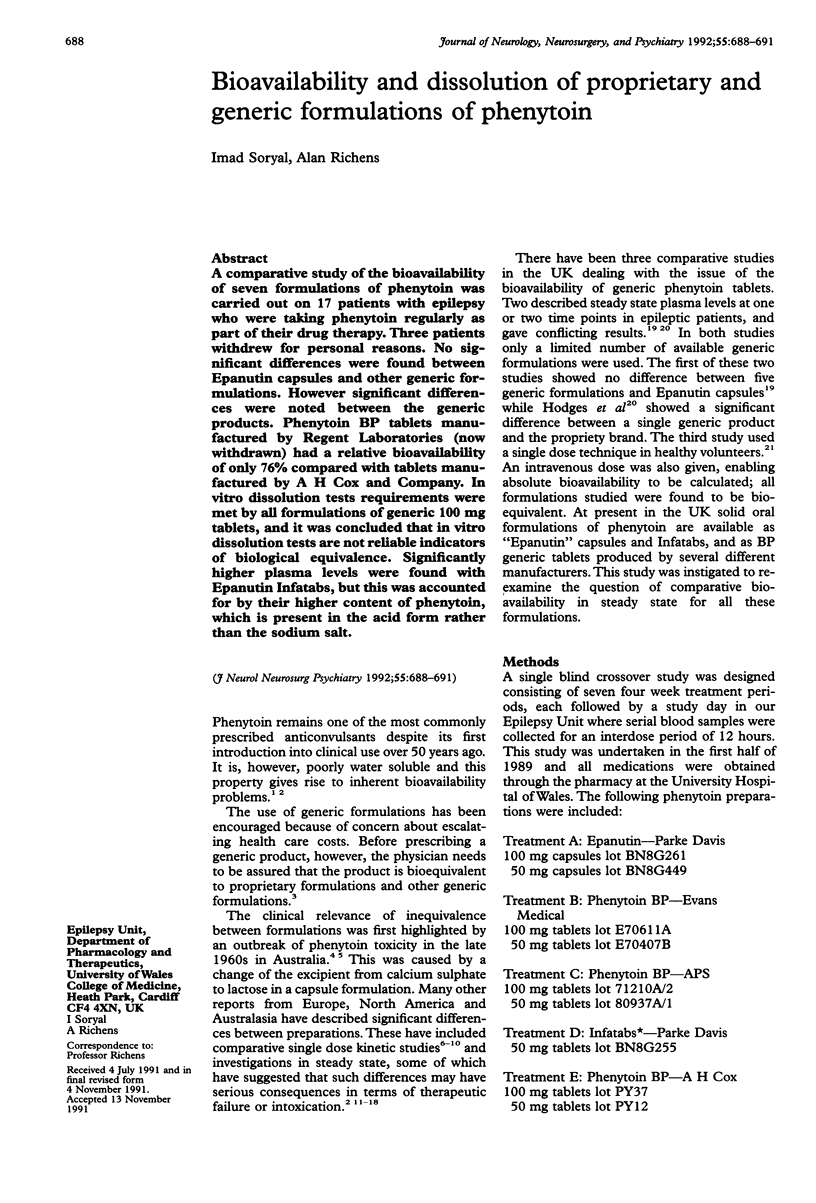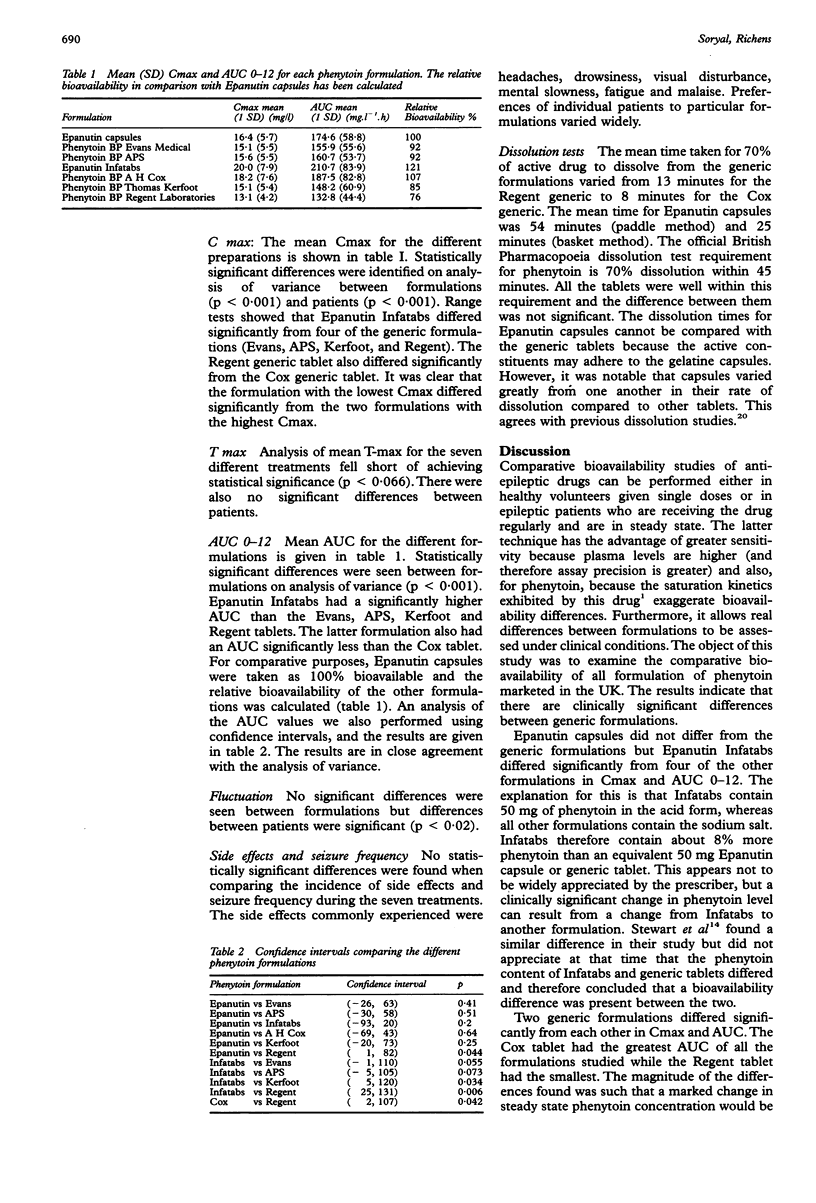Abstract
A comparative study of the bioavailability of seven formulations of phenytoin was carried out on 17 patients with epilepsy who were taking phenytoin regularly as part of their drug therapy. Three patients withdrew for personal reasons. No significant differences were found between Epanutin capsules and other generic formulations. However significant differences were noted between the generic products. Phenytoin BP tablets manufactured by Regent Laboratories (now withdrawn) had a relative bioavailability of only 76% compared with tablets manufactured by A H Cox and Company. In vitro dissolution tests requirements were met by all formulations of generic 100 mg tablets, and it was concluded that in vitro dissolution tests are not reliable indicators of biological equivalence. Significantly higher plasma levels were found with Epanutin Infatabs, but this was accounted for by their higher content of phenytoin, which is present in the acid form rather than the sodium salt.
Full text
PDF



Selected References
These references are in PubMed. This may not be the complete list of references from this article.
- Appleton D. B., Eadie M. J., Hooper W. D., Lucas B., Sutherland J. M., Tyrer J. H. Blood phenytoin concentrations produced by ingestion of three different phenytoin preparations. Med J Aust. 1972 Feb 26;1(9):410–411. doi: 10.5694/j.1326-5377.1972.tb106535.x. [DOI] [PubMed] [Google Scholar]
- Bochner F., Hooper W. D., Tyrer J. H., Eadie M. J. Factors involved in an outbreak of phenytoin intoxication. J Neurol Sci. 1972 Aug;16(4):481–487. doi: 10.1016/0022-510x(72)90053-6. [DOI] [PubMed] [Google Scholar]
- Chen S. S., Allen J., Oxley J., Richens A. Comparative bioavailability of phenytoin from generic formulations in the United Kingdom. Epilepsia. 1982 Apr;23(2):149–152. doi: 10.1111/j.1528-1157.1982.tb05062.x. [DOI] [PubMed] [Google Scholar]
- Gugler R., Manion C. V., Azarnoff D. L. Phenytoin: pharmacokinetics and bioavailability. Clin Pharmacol Ther. 1976 Feb;19(2):135–142. doi: 10.1002/cpt1976192135. [DOI] [PubMed] [Google Scholar]
- Hirji M. R., Measuria H., Kuhn S., Mucklow J. C. A comparative study of the bioavailability of five different phenytoin preparations. J Pharm Pharmacol. 1985 Aug;37(8):570–572. doi: 10.1111/j.2042-7158.1985.tb03070.x. [DOI] [PubMed] [Google Scholar]
- Hodges S., Forsythe W. I., Gillies D., Remington H., Cawood A. Bio-availability and dissolution of three phenytoin preparations for children. Dev Med Child Neurol. 1986 Dec;28(6):708–712. doi: 10.1111/j.1469-8749.1986.tb03921.x. [DOI] [PubMed] [Google Scholar]
- Lund L. Clinical significance of generic inequivalence of three different pharmaceutical preparations of phenytoin. Eur J Clin Pharmacol. 1974;7(2):119–124. doi: 10.1007/BF00561325. [DOI] [PubMed] [Google Scholar]
- Manson J. I., Beal S. M., Magarey A., Pollard A. C., O'Reilly W. J., Sansom L. N. Bioavailability of phenytoin from various pharmaceutical preparations in children. Med J Aust. 1975 Oct 11;2(15):590–592. doi: 10.5694/j.1326-5377.1975.tb106113.x. [DOI] [PubMed] [Google Scholar]
- Neuvonen P. J., Bardy A., Lehtovaara R. Effect of increased bioavailability of phenytoin tablets on serum phenytoin concentration in epileptic out-patients. Br J Clin Pharmacol. 1979 Jul;8(1):37–41. doi: 10.1111/j.1365-2125.1979.tb05906.x. [DOI] [PMC free article] [PubMed] [Google Scholar]
- Neuvonen P. J., Pentikäinen P. J., Elfving S. M. Factors affecting the bioavailability of phenytoin. Int J Clin Pharmacol Biopharm. 1977 Feb;15(2):84–89. doi: 10.103/00006450-11000-00005. [DOI] [PubMed] [Google Scholar]
- Nuwer M. R., Browne T. R., Dodson W. E., Dreifuss F. E., Engel J., Jr, Leppik I. E., Mattson R. H., Penry J., Treiman D. M., Wilder B. J. Generic substitutions for antiepileptic drugs. Neurology. 1990 Nov;40(11):1647–1651. doi: 10.1212/wnl.40.11.1647. [DOI] [PubMed] [Google Scholar]
- Pentikäinen P. J., Neuvonen P. J., Elfving S. M. Bioavailability of four brands of phenytoin tablets. Eur J Clin Pharmacol. 1975 Dec 19;9(2-3):213–218. doi: 10.1007/BF00614020. [DOI] [PubMed] [Google Scholar]
- Rambeck B., Boenigk H. E., Stenzel E. Bioavailability of three phenytoin preparations in healthy subjects and in epileptics. Eur J Clin Pharmacol. 1977 Dec 2;12(4):285–290. doi: 10.1007/BF00607428. [DOI] [PubMed] [Google Scholar]
- Richens A. Clinical pharmacokinetics of phenytoin. Clin Pharmacokinet. 1979 May-Jun;4(3):153–169. doi: 10.2165/00003088-197904030-00001. [DOI] [PubMed] [Google Scholar]
- Sansom L. N., O'Reilly W. J., Wiseman C. W., Stern L. M., Derham J. Plasma phenytoin levels produced by various phenytoin preparations. Med J Aust. 1975 Oct 11;2(15):593–595. [PubMed] [Google Scholar]
- Stewart M. J., Ballinger B. R., Devlin E. J., Miller A. Y., Ramsay A. C. Bioavailability of phenytoin. A comparison of two preparations. Eur J Clin Pharmacol. 1975 Dec 19;9(2-3):209–212. doi: 10.1007/BF00614019. [DOI] [PubMed] [Google Scholar]
- Tammisto P., Kauko K., Viukari M. Letter: Bioavailability of phenytoin. Lancet. 1976 Jan 31;1(7953):254–255. doi: 10.1016/s0140-6736(76)91382-9. [DOI] [PubMed] [Google Scholar]
- Tyrer J. H., Eadie M. J., Sutherland J. M., Hooper W. D. Outbreak of anticonvulsant intoxication in an Australian city. Br Med J. 1970 Oct 31;4(5730):271–273. doi: 10.1136/bmj.4.5730.271. [DOI] [PMC free article] [PubMed] [Google Scholar]


